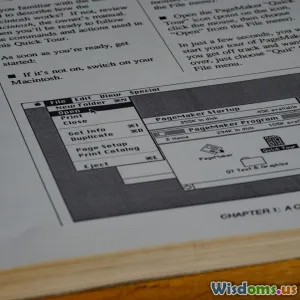
What Sets Great Software Writing Apart from the Average
8 min read Discover the key qualities that distinguish exceptional software writing from the mediocre, enhancing clarity, maintainability, and developer collaboration. (0 Reviews)
What Sets Great Software Writing Apart from the Average
In the realm of software development, code isn’t simply lines written to get the job done—it’s a language that communicates intent, logic, and creativity. Yet, many developers produce code that just works, lacking the finesse or clarity that elevates code from functional to exceptional. So, what really distinguishes great software writing from average or mediocre code? This article delves into key traits, practices, and philosophies that shape outstanding software writing, supported by real-world examples and expert insights.
Introduction: The Hidden Power of Great Software Writing
The quality of software writing impacts not only the immediate outcome but all future work that touches that codebase. Grace Hopper, a pioneer of computer programming, famously said, "The most dangerous phrase in the language is, 'We've always done it this way.'" Stagnant, unclear, or poorly written code perpetuates maintenance nightmares, slows down teams, and increases bugs. Conversely, great software writing fosters agility, promotes team coherence, and streamlines debugging and feature addition.
Think of software writing as crafting a narrative where every character, every word, and every paragraph serves a precise purpose. The difference between great and average developers often lies in how adeptly they tell this technical story.
The Anatomy of Great Software Writing
1. Clarity Above All
Great software is inherently clear. This does not mean simplifying your software to the point of triviality, but rather making the intent and structure evident at a glance.
-
Readable Naming Conventions: Names like
calculateInvoiceTotal()are explicitly more descriptive thancalcIt(). Well-chosen names act as mini-documentation, reducing cognitive load. -
Self-Explanatory Logic: Instead of packing complicated logic into dense, nested loops, good developers break down processes into understandable units or helper functions.
Example:
Consider two function declarations handling date parsing:
Average Example:
def dtp(d):
return pd.to_datetime(d)
Great Example:
def parse_user_input_date(date_string: str) -> datetime:
"""Convert user input into a UTC datetime object."""
return pd.to_datetime(date_string).tz_localize('UTC')
The second example not only improves naming clarity but adds useful inline documentation and context.
2. Maintainability Is a Priority
Code, unlike a novel, isn’t static. It evolves over months or years. Great software writing anticipates change.
-
Modular Design: Dividing complex systems into independent modules allows for localized updates without breaking unrelated features.
-
Consistent Style and Conventions: Teams adhering to style guides like PEP 8 (Python) or Airbnb's JavaScript style guide facilitate smoother collaboration.
Data Insight:
According to a 2019 State of Software Development survey, consistently styled codebases improve team productivity by up to 25% and reduce bug rates by roughly 16%.
3. Efficiency Without Sacrifice
While performance optimization is essential, premature or unreadable optimization hampers maintainability. Great software writing strikes a balance by writing efficient code that remains readable.
For example, using list comprehensions in Python:
# Average: verbose and slower
squares = []
for x in range(10):
squares.append(x**2)
# Great: concise and efficient
squares = [x**2 for x in range(10)]
This clarity-driven efficiency accelerates both execution and human understanding.
4. Thoughtful Documentation and Contextual Comments
Clear comments don’t just restate code—they explain why something is done, not what. This subtle difference is crucial for future developers who may grapple with non-obvious decisions hiding in the code.
Expert Insight:
Joel Spolsky, in his article "The Joel Test," emphasizes that good code must be "read more often than written," highlighting the enduring need for accurate documentation.
5. Robust Testing Integration
Exceptional software writing integrates automated testing deeply into the development process.
- Unit Tests: Test small components in isolation.
- Integration Tests: Verify combined parts work as expected.
- Test-Driven Development (TDD): Writing tests before code can substantially improve design and reliability.
Practices like Continuous Integration/Continuous Deployment (CI/CD) from companies like Netflix and Amazon prove that comprehensive testing is non-negotiable for resilient software.
6. Adaptability and Forward-Thinking
Great developers anticipate future scenarios, ensuring their code can be extended or scaled as requirements evolve.
For instance, the use of design patterns like Dependency Injection allows easier replacement of modules, making the system more flexible.
Real-World Examples: When Software Writing Makes a Difference
Mozilla Firefox’s Commitment to Code Quality
Mozilla's open-source project encourages continuous code review and refactoring. Their use of Rust to replace critical components reduced memory bugs drastically while emphasizing code safety and clarity.
Google's Google Style Guides
Google publicly shares comprehensive style guides for multiple languages, reflecting their prioritization of readable and maintainable code, essential for thousands of developers collaborating globally.
The Linux Kernel
The Linux kernel source code exemplifies meticulous documentation and modular design, maintained by thousands of contributors. Standards, peer reviews, and revoke extensive debugging have made it a reliable pillar of modern infrastructure.
Conclusion: How to Elevate Your Software Writing
Great software writing is more than technical skill; it’s an artform combining clarity, foresight, and collaboration. By prioritizing readability, maintainability, proper documentation, and testing, developers ensure their code is not just functional but sustainable and scalable.
Remember the words of Martin Fowler, renowned software engineer: "Any fool can write code that a computer can understand. Good programmers write code that humans can understand." Striving for excellence in software writing is an ongoing journey—requiring discipline, humility to refactor, and passion to learn.
Embrace this mindset, and your codebase won't just be a tool—it will be a long-lived asset, admired not only for what it does but how elegantly it does it.
Call to action: Reflect on your recent project—could your code benefit from clearer naming, more modular structure, or better testing? Start incorporating one principle today and witness transformative results over time.
References:
- Joel Spolsky, “The Joel Test: 12 Steps To Better Code.”
- Martin Fowler, “Refactoring: Improving the Design of Existing Code.”
- 2019 State of Software Development Survey, Stack Overflow
- Google Open Source Style Guides
- Mozilla Developer Network
Rate the Post
User Reviews
Popular Posts



















